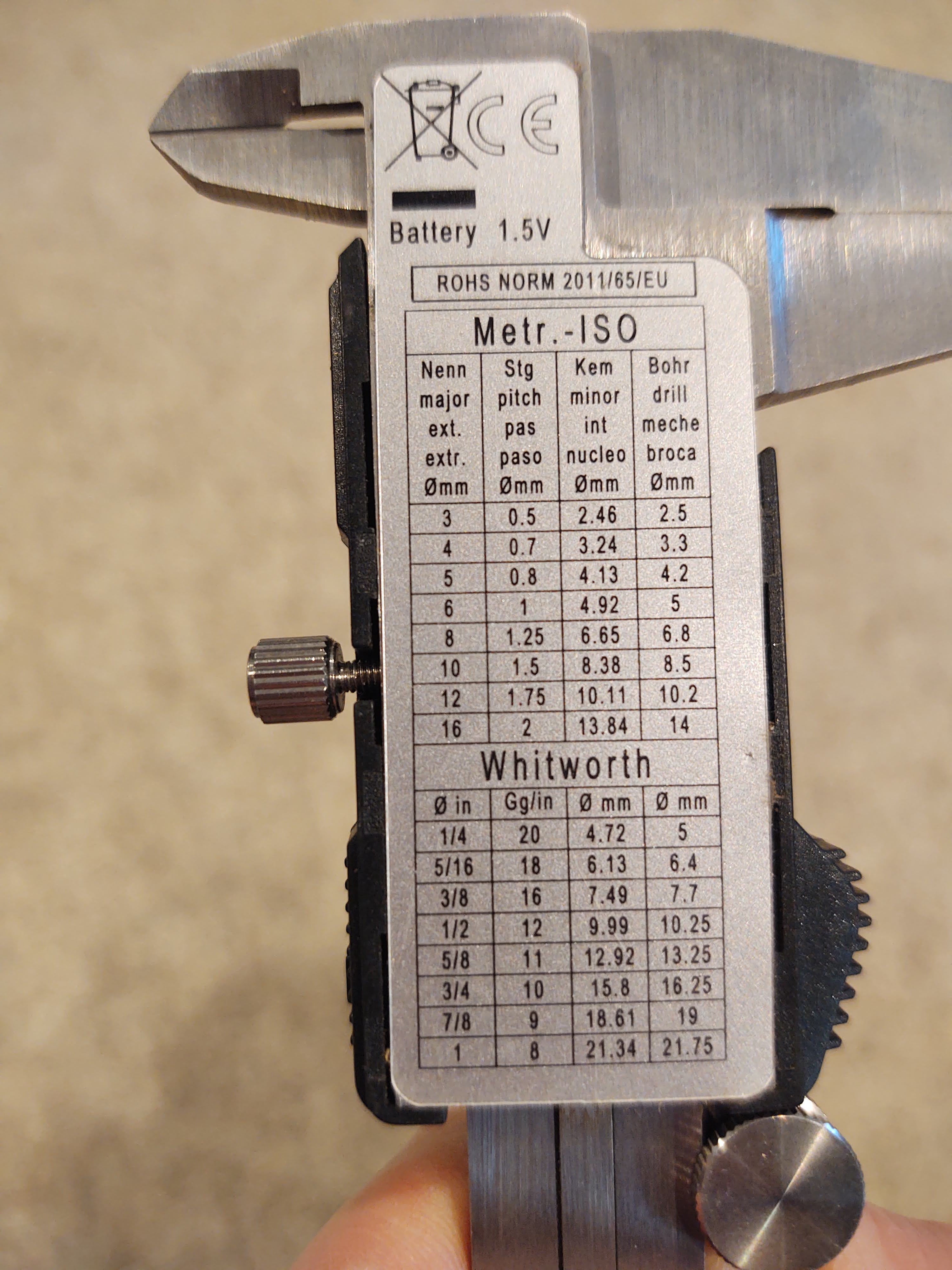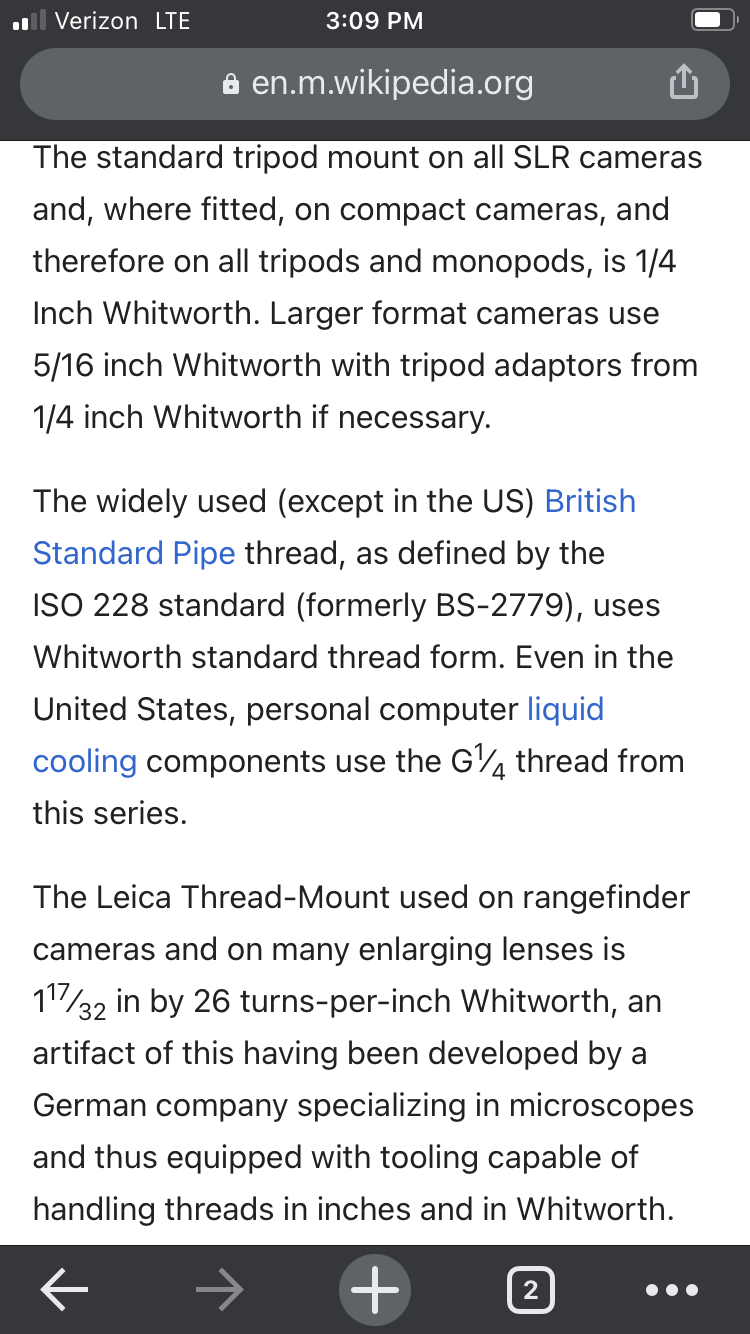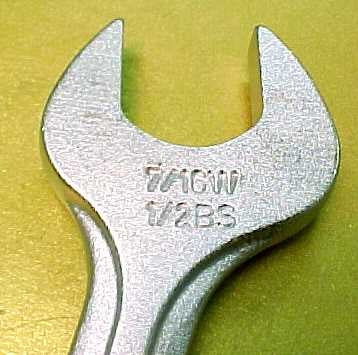 "CalzoneGolem" (calzonegolem)
"CalzoneGolem" (calzonegolem)
10/08/2020 at 14:49 • Filed to: None
 2
2
 30
30
 "CalzoneGolem" (calzonegolem)
"CalzoneGolem" (calzonegolem)
10/08/2020 at 14:49 • Filed to: None |  2 2
|  30 30 |
I was looking at the back of my digital calipers when I noticed ...

Whitworth? Who tf needs this chart?
 Boxer_4
> CalzoneGolem
Boxer_4
> CalzoneGolem
10/08/2020 at 14:55 |
|
People working on old British cars? My thread pitch gauge is a metric whitworth combo. I usually only work in metric at this point, but metric and SAE would probably be more useful.
 MM54
> CalzoneGolem
MM54
> CalzoneGolem
10/08/2020 at 14:56 |
|
The sad thing is that those aren’t whitworth threads listed, those are UNC.
Thanks, China.
 benjrblant
> CalzoneGolem
benjrblant
> CalzoneGolem
10/08/2020 at 14:56 |
|
my copy of machinery’s handbook, 17th ed (1964) has pages for converting liquid measures such as tun, pipe, puncheons, tierces, and hogsheads.
1 hogshead is approx 63 gallons, if that was keeping you up at night or something.
 Arch Duke Maxyenko, Shit Talk Extraordinaire
> CalzoneGolem
Arch Duke Maxyenko, Shit Talk Extraordinaire
> CalzoneGolem
10/08/2020 at 14:57 |
|
Gunsmiths, camera people, and Satan.
 CalzoneGolem
> MM54
CalzoneGolem
> MM54
10/08/2020 at 14:59 |
|
Even better!
 Chariotoflove
> benjrblant
Chariotoflove
> benjrblant
10/08/2020 at 15:00 |
|
Aaaand I now have my Dinner Fact ™ for tonight, thank you.
 CalzoneGolem
> benjrblant
CalzoneGolem
> benjrblant
10/08/2020 at 15:00 |
|
I actually knew how many gallons are in a hogshead. Strangely enough.
 CalzoneGolem
> Arch Duke Maxyenko, Shit Talk Extraordinaire
CalzoneGolem
> Arch Duke Maxyenko, Shit Talk Extraordinaire
10/08/2020 at 15:01 |
|
Are you for real? Do guns and cameras really use whitworth?
 benjrblant
> CalzoneGolem
benjrblant
> CalzoneGolem
10/08/2020 at 15:04 |
|
i bet that comes in handy
 HammerheadFistpunch
> Arch Duke Maxyenko, Shit Talk Extraordinaire
HammerheadFistpunch
> Arch Duke Maxyenko, Shit Talk Extraordinaire
10/08/2020 at 15:10 |
|
Camera people? GTFO. my life is 1/4 #20
 Arch Duke Maxyenko, Shit Talk Extraordinaire
> CalzoneGolem
Arch Duke Maxyenko, Shit Talk Extraordinaire
> CalzoneGolem
10/08/2020 at 15:10 |
|
Old guns, yes.

 CalzoneGolem
> benjrblant
CalzoneGolem
> benjrblant
10/08/2020 at 15:11 |
|
Yeah I’m shipping 1/4 Tuns of liquid all the time.
 MasterMario - Keeper of the V8s
> CalzoneGolem
MasterMario - Keeper of the V8s
> CalzoneGolem
10/08/2020 at 15:11 |
|
Due to the S impsons? That’s why I know it.


 CalzoneGolem
> Arch Duke Maxyenko, Shit Talk Extraordinaire
CalzoneGolem
> Arch Duke Maxyenko, Shit Talk Extraordinaire
10/08/2020 at 15:12 |
|
What ... why?
 CalzoneGolem
> MasterMario - Keeper of the V8s
CalzoneGolem
> MasterMario - Keeper of the V8s
10/08/2020 at 15:13 |
|
Nah I had some binder in high sc hool with a bunch of conversions liste d in in and that one made me laugh so it stuck,
 DasWauto
> MM54
DasWauto
> MM54
10/08/2020 at 15:14 |
|
I’m pretty sure 1/2” is 13 TPI for UNC, as opposed to 12 above, I think 9/16” is 12 TPI for UNC.
 Darkbrador
> CalzoneGolem
Darkbrador
> CalzoneGolem
10/08/2020 at 15:20 |
|
Who needs it ? People who have an annuity but need the cash now. I heard.
 Cé hé sin
> Boxer_4
Cé hé sin
> Boxer_4
10/08/2020 at 15:56 |
|
Had to Google SAE, being only famili ar with imperial and metric.
Turns out that SAE is a system of parts and tools made to something called
USCS units, equally new to me
.
 MM54
> DasWauto
MM54
> DasWauto
10/08/2020 at 17:15 |
|
Could be. 5/8-11 and 1-8 are common, I don’t deal much with >1/2" to know
that part of the table off-hand.
 WasGTIthenGTOthenNOVAnowbacktoGTI
> CalzoneGolem
WasGTIthenGTOthenNOVAnowbacktoGTI
> CalzoneGolem
10/08/2020 at 17:24 |
|
“ Because fuck you, that’s why” I’m guessing.
 TheBloody, Oppositelock lives on in our shitposts.
> CalzoneGolem
TheBloody, Oppositelock lives on in our shitposts.
> CalzoneGolem
10/08/2020 at 17:30 |
|
Errr... Me?

 DasWauto
> MM54
DasWauto
> MM54
10/08/2020 at 17:49 |
|
When I worked in manufacturing we used 1/2-13 and 3/8-16 for most of the fixtures we designed/built, which always amused me because the parts we were machining or assembling in said fixtures were designed in metric. :)
 shop-teacher
> Cé hé sin
shop-teacher
> Cé hé sin
10/08/2020 at 19:17 |
|
SAE is Standard American- English. Otherwise known as inches and feet . Otherwise known as freedom units.
#metricisforcommunists, #jus tbecausemetricisfarmorelogicalandbetterdoesn’tmakeitbetter
 Cé hé sin
> shop-teacher
Cé hé sin
> shop-teacher
10/08/2020 at 19:26 |
|
I remember tools in fractions of an inch but they were always called Imperial! SAE tools use different fractions of an inch or something. Also, you still come across (well, I do...) tools with both BS and Whitworth sizes.

 shop-teacher
> Cé hé sin
shop-teacher
> Cé hé sin
10/08/2020 at 19:29 |
|
Imperial and SAE are functionally the same. I've always heard the names used interchangeably.
I've never into BS or Whitworth, but I've never worked on any British cars :)
 oldmxer
> CalzoneGolem
oldmxer
> CalzoneGolem
10/09/2020 at 01:52 |
|
speaking from 50 years of machine shop, machinists
 CalzoneGolem
> oldmxer
CalzoneGolem
> oldmxer
10/09/2020 at 09:04 |
|
You need W hitworth thread pitches often?
 CalzoneGolem
> TheBloody, Oppositelock lives on in our shitposts.
CalzoneGolem
> TheBloody, Oppositelock lives on in our shitposts.
10/09/2020 at 09:04 |
|
Yeah I figured you’d find it useful.
 oldmxer
> CalzoneGolem
oldmxer
> CalzoneGolem
10/10/2020 at 04:27 |
|
actually that is a bad attempt at labeling by what I assume is a chinese made? caliper, the attendant info is actually just american std info, having really nothing to do with actual whitworth threads, as i understand it the whitworth threads were abandoned in the late 60's early 70's in favor of the american std. I started in the machine shop business in 74 and cut thousands of threads over the years and never had to encounter a situation where whitworth came up even though we were in the business of repairing and restoring older equipment. as one of the older guys told me the main difference was the angle of the thread form, the american std is 60 degrees and the whitworth was 55, so we may or may not have encountered some over the years and depending on the tolerance an american bolt fit in a whitworth threaded hole and no one knew any diff. or just assumed it was buggered and chased it with a tap
 CalzoneGolem
> oldmxer
CalzoneGolem
> oldmxer
10/12/2020 at 07:32 |
|
Well it’s good to know that these aren’t W hitworth the american std info might actually be useful to me